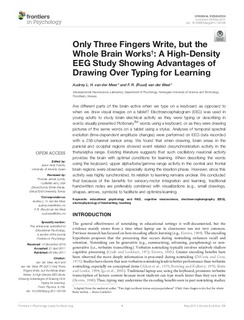| dc.contributor.author | Meer, Audrey van der | |
| dc.contributor.author | Van der Weel, Frederikus | |
| dc.date.accessioned | 2017-12-13T09:07:01Z | |
| dc.date.available | 2017-12-13T09:07:01Z | |
| dc.date.created | 2017-04-24T15:40:08Z | |
| dc.date.issued | 2017 | |
| dc.identifier.citation | Frontiers in Psychology. 2017, 8 . | nb_NO |
| dc.identifier.issn | 1664-1078 | |
| dc.identifier.uri | http://hdl.handle.net/11250/2470975 | |
| dc.description.abstract | Are different parts of the brain active when we type on a keyboard as opposed to when we draw visual images on a tablet? Electroencephalogram (EEG) was used in young adults to study brain electrical activity as they were typing or describing in words visually presented PictionaryTM words using a keyboard, or as they were drawing pictures of the same words on a tablet using a stylus. Analyses of temporal spectral evolution (time-dependent amplitude changes) were performed on EEG data recorded with a 256-channel sensor array. We found that when drawing, brain areas in the parietal and occipital regions showed event related desynchronization activity in the theta/alpha range. Existing literature suggests that such oscillatory neuronal activity provides the brain with optimal conditions for learning. When describing the words using the keyboard, upper alpha/beta/gamma range activity in the central and frontal brain regions were observed, especially during the ideation phase. However, since this activity was highly synchronized, its relation to learning remains unclear. We concluded that because of the benefits for sensory-motor integration and learning, traditional handwritten notes are preferably combined with visualizations (e.g., small drawings, shapes, arrows, symbols) to facilitate and optimize learning. | nb_NO |
| dc.language.iso | eng | nb_NO |
| dc.publisher | Frontiers Media | nb_NO |
| dc.rights | Navngivelse 4.0 Internasjonal | * |
| dc.rights.uri | http://creativecommons.org/licenses/by/4.0/deed.no | * |
| dc.title | Only three fingers write, but the whole brain works: A high-density EEG study showing advantages of drawing over typing for learning. | nb_NO |
| dc.type | Journal article | nb_NO |
| dc.type | Peer reviewed | nb_NO |
| dc.description.version | publishedVersion | nb_NO |
| dc.source.pagenumber | 9 | nb_NO |
| dc.source.volume | 8 | nb_NO |
| dc.source.journal | Frontiers in Psychology | nb_NO |
| dc.identifier.doi | 10.3389/fpsyg.2017.00706 | |
| dc.identifier.cristin | 1466292 | |
| dc.description.localcode | © 2017 van der Meer and van der Weel. This is an open-access article distributed under the terms of the Creative Commons Attribution License (CC BY). The use, distribution or reproduction in other forums is permitted, provided the original author(s) or licensor are credited and that the original publication in this journal is cited, in accordance with accepted academic practice. No use, distribution or reproduction is permitted which does not comply with these terms. | nb_NO |
| cristin.unitcode | 194,67,40,0 | |
| cristin.unitname | Institutt for psykologi | |
| cristin.ispublished | true | |
| cristin.fulltext | postprint | |
| cristin.fulltext | original | |
| cristin.qualitycode | 2 | |

